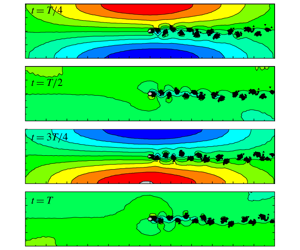Article contents
Frequency lock-in mechanism in flow-induced acoustic resonance of a cylinder in a flow duct
Published online by Cambridge University Press: 17 December 2019
Abstract

The vortex sound interaction in acoustic resonance induced by vortex shedding from a cylinder in a flow duct is numerically studied based on a nonlinear physical model, which consists of three meshless sub-models describing the vortex shedding, sound generation and propagation within the duct. In addition, the acoustic particle velocity near the separation point of the shear layer is solved and added onto the Kutta condition of the vortex shedding, which takes the acoustic feedback effect into consideration and makes the vortex sound interaction bi-directional. The predicted results of resonant frequency and amplitude are found to be in conformity with previous experiment data, especially, a continuous description of the onset–sustain–cease of lock-in phenomenon is well captured. The lock-in phenomenon is depicted as a vigorous competition between the vortex shedding frequency  $(f_{s})$ and the inherent frequency of the acoustic
$(f_{s})$ and the inherent frequency of the acoustic  $\unicode[STIX]{x1D6FD}$-mode
$\unicode[STIX]{x1D6FD}$-mode  $(f_{a})$. The mutual capturing behaviour of these two frequencies is dominated by
$(f_{a})$. The mutual capturing behaviour of these two frequencies is dominated by  $f_{a}$. Moreover,
$f_{a}$. Moreover,  $f_{s}$ cannot always be locked onto
$f_{s}$ cannot always be locked onto  $f_{a}$ within the whole lock-in region, which is in marked contrast to the previous understanding. In this aspect, two lock-in regions, the synchronous region and the
$f_{a}$ within the whole lock-in region, which is in marked contrast to the previous understanding. In this aspect, two lock-in regions, the synchronous region and the  $\unicode[STIX]{x1D6FD}$-mode dominant region, are defined according to the relevance of
$\unicode[STIX]{x1D6FD}$-mode dominant region, are defined according to the relevance of  $f_{s}$ and
$f_{s}$ and  $f_{a}$. The maximum resonant sound appears at the end of the synchronous region. The present model not only predicts the proper characteristics of frequency lock-in as observed in experiments, but also helps to provide a more detailed understanding of the underlying lock-in mechanism.
$f_{a}$. The maximum resonant sound appears at the end of the synchronous region. The present model not only predicts the proper characteristics of frequency lock-in as observed in experiments, but also helps to provide a more detailed understanding of the underlying lock-in mechanism.
- Type
- JFM Papers
- Information
- Copyright
- © 2019 Cambridge University Press
References
- 16
- Cited by




